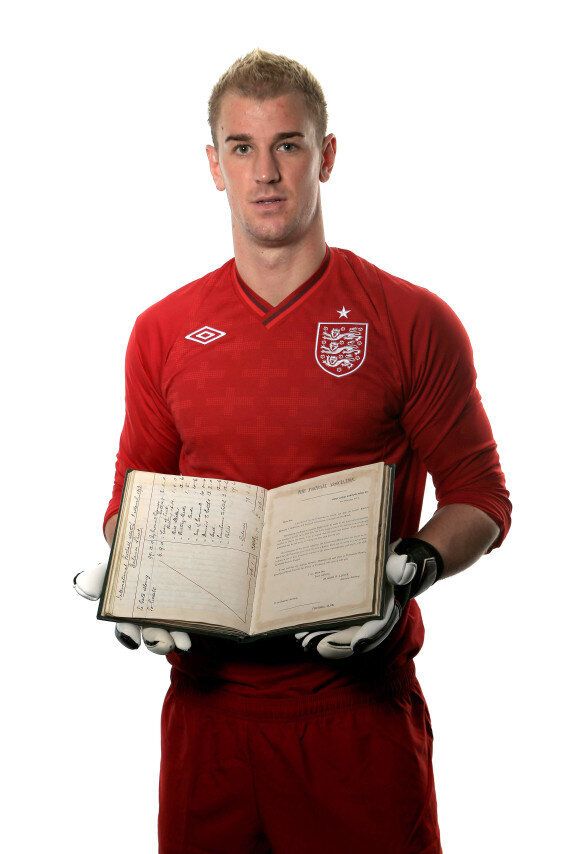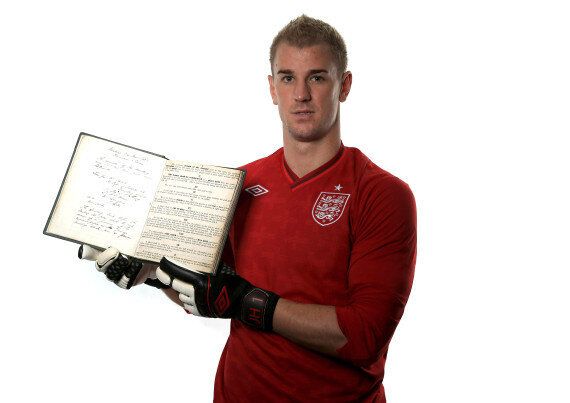England goalkeeper, Joe Hart is pictured with the handwritten ‘Minute Book’ containing the original laws of football, that began to be developed in 1863 and is valued at £1 million, to mark the Football Association's 149th
birthday.

Written by Ebenezer Morley, the first secretary of the FA, The FA Minute Book, featuring the 13 original laws of organised football, is the centrepiece for narrating the historical origin of the beautiful game that the world knows and plays today.

Interestingly, the laws outlined in the 1863 publication would not have favoured Joe Hart’s goalkeeping excellence. They not only stated that ‘no player shall carry the ball’ but the goalkeeper position didn’t even exist in the early days of the football.

From January 2013, The FA will begin to celebrate its anniversary with a year-long calendar of events. England will face Brazil, Scotland and Republic of Ireland in the new year as well as tour the 2014 World Cup host nation
FA150 in Numbers
- £1.1s: the per annum cost for a club to join The FA in 1863.
- 6: members of the Royal Family who have held the position of FA President.
- 6: the number of meetings it took to develop the original laws.
- 11: the number of clubs who signed up when The FA was formed.
- 13: original laws of the game.
- 0-0: the score line of first game played under the original laws.
- 100: the maximum breadth (in yards) a pitch is allowed to be under the original laws.
- 200: the maximum length (in yards) a pitch is allowed to be under the original laws.
- 208: the number of national Football Associations created around the world since 1863.
- 4,000: attendance at the first official England international, played on 30th November 1872.
- 27,000: number of qualified referees in 2012.
- 300,000: number of qualified coaches today in 2012.
- 400,000: people volunteer their time for football in 2012.
- 7,000,000: people play football on a regular basis in 2012.
The 1863 rules are:
- The maximum length of the ground shall be 200 yards, the maximum breadth shall be 100 yards, the length and breadth shall be marked off with flags; and the goals shall be defined by two upright posts, 8 yards apart, without any tape or bar across them
- The winner of the toss shall have the choice of goals. The game shall be commenced by a place kick from the centre of the ground by the side losing the toss, the other side shall not approach within 10 yards of the ball until it is kicked off
- After a goal is won the losing side shall kick off and goals shall be changed
- A goal shall be won when the ball passes between the goal posts or over the space between the goal posts (at whatever height), not being thrown, knocked on, or carried
- When the ball is in touch the first player who touches it shall throw it from the point on the boundary line where it left the ground, in a direction at right angles with the boundary line and it shall not be in play until it has touched the ground
- When a player has kicked the ball any one of the same side who is nearer to the opponent’s goal line is out of play and may not touch the ball himself nor in any way whatever prevent any other player from doing so until the ball has been played; but no player is out of play when the ball is kicked from behind the goal line
- In case the ball goes behind the goal line, if a player on the side to whom the goal belongs first touches the ball, one of his side shall be entitled to a free kick from the goal line at the point opposite the place where the ball shall be touched. If a player of the opposite side first touches the ball, one of his side shall be entitled to a free kick (but at the goal only) from a point 15 yards from the goal line opposite the place where the ball is touched. The opposing side shall stand behind their goal line until he has had his kick
- If a player makes a fair catch he shall be entitled to a free kick, provided he claims it by making a mark with his heel at once; ad in order to take such kick he may go as far back as he pleases, and no player on the opposite side shall advance beyond his mark until he has kicked
- No player shall carry the ball
- Neither tripping nor hacking shall be allowed and no player shall use his hands to hold or push his adversary
- A player shall not throw the ball or pass it to another
- No player shall take the ball from the ground with his hands while it is in play under any pretence whatever
- No player shall wear projecting nails, iron plates, or gutta percha on the soles or heels of his boots